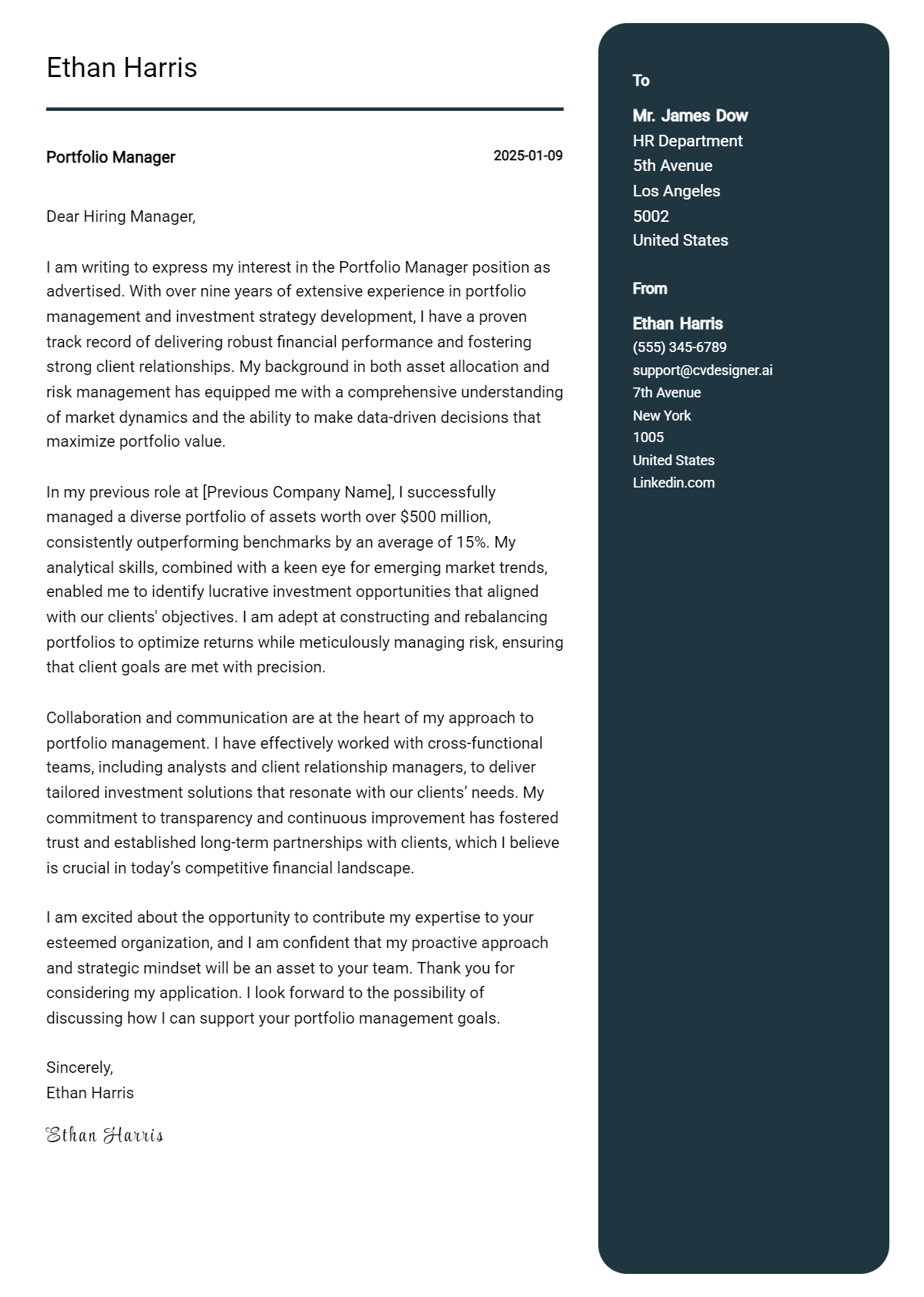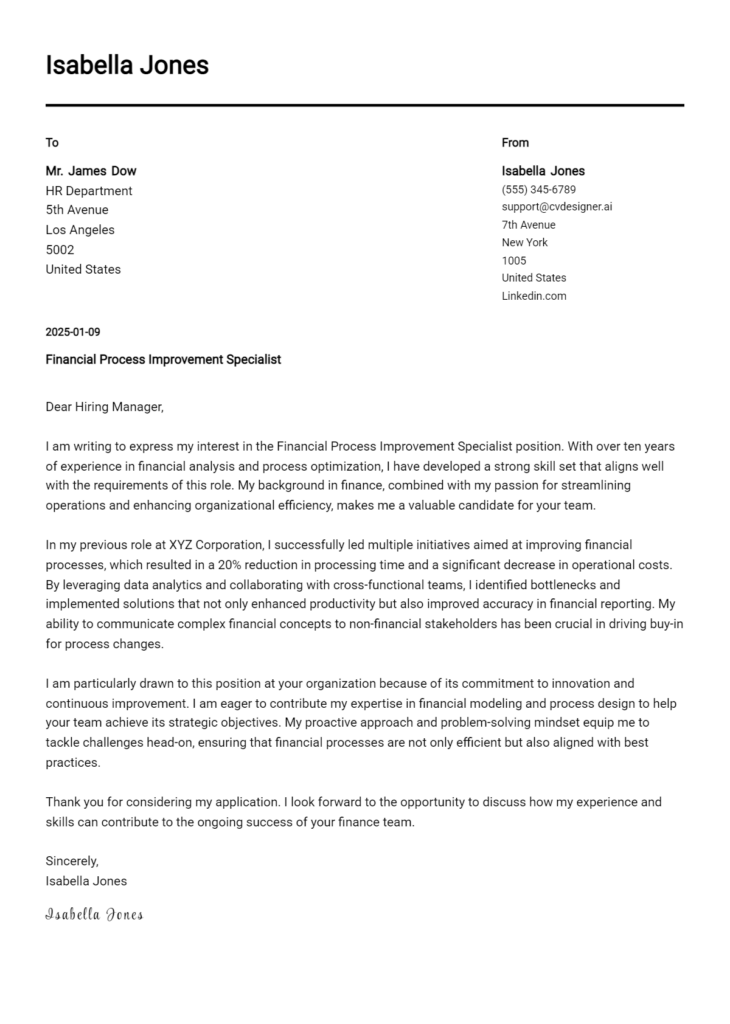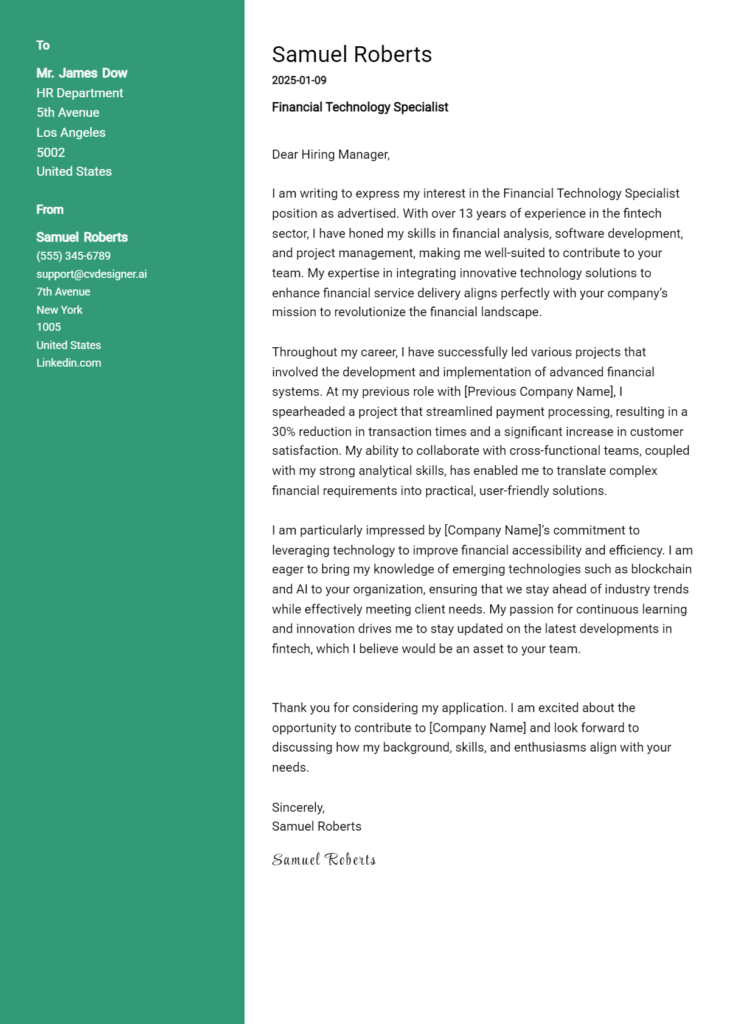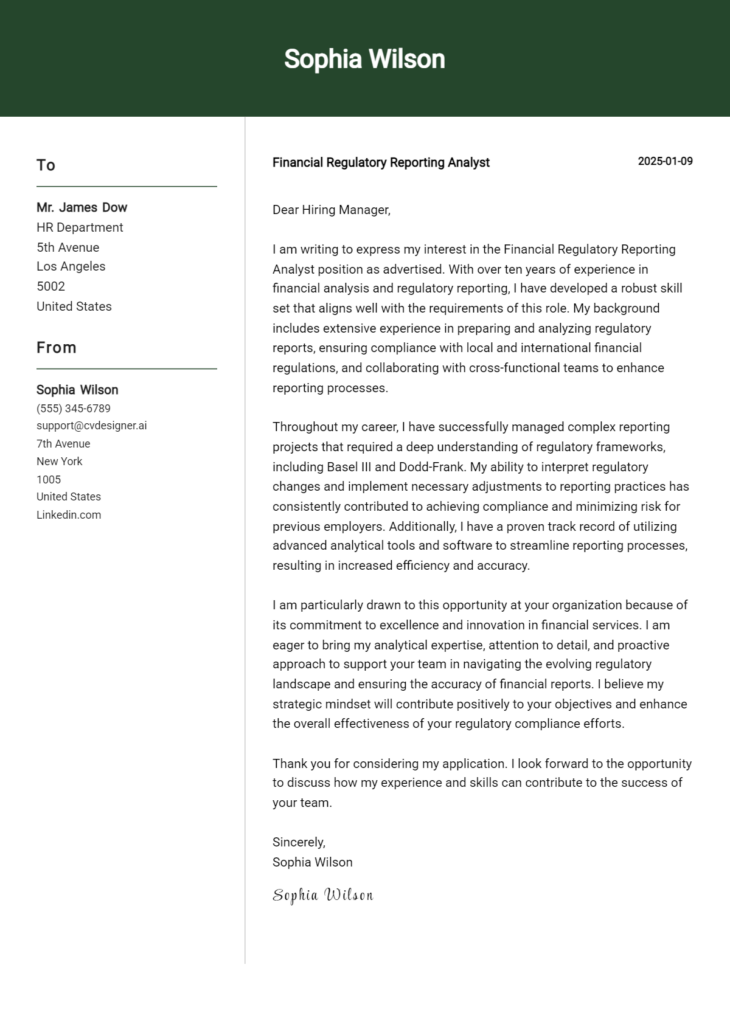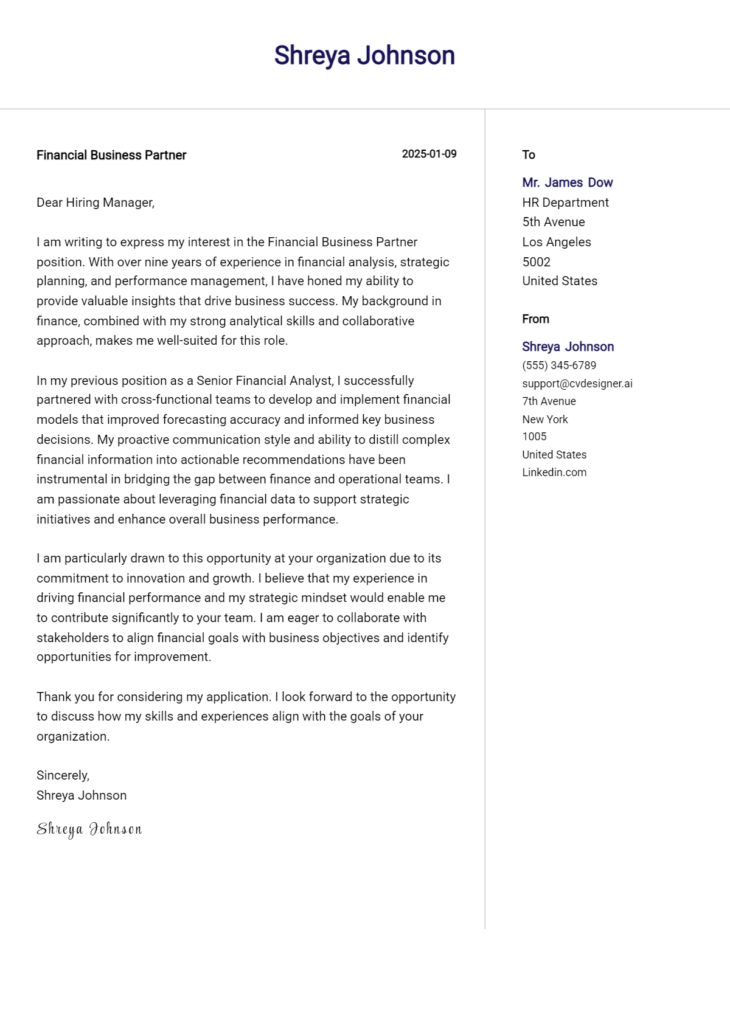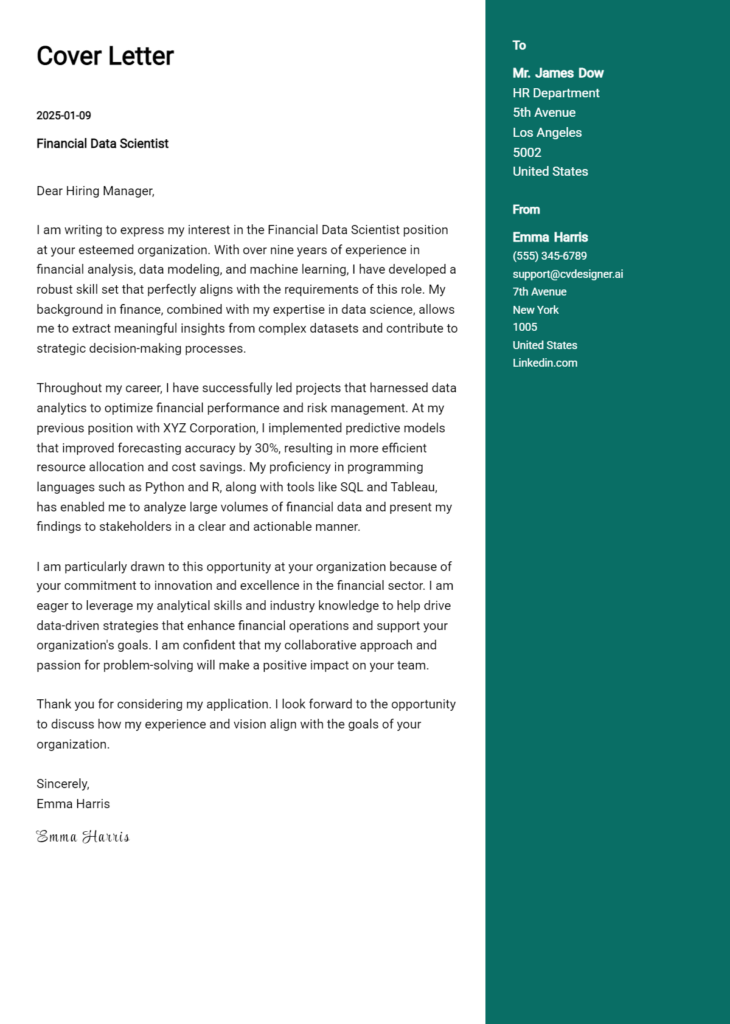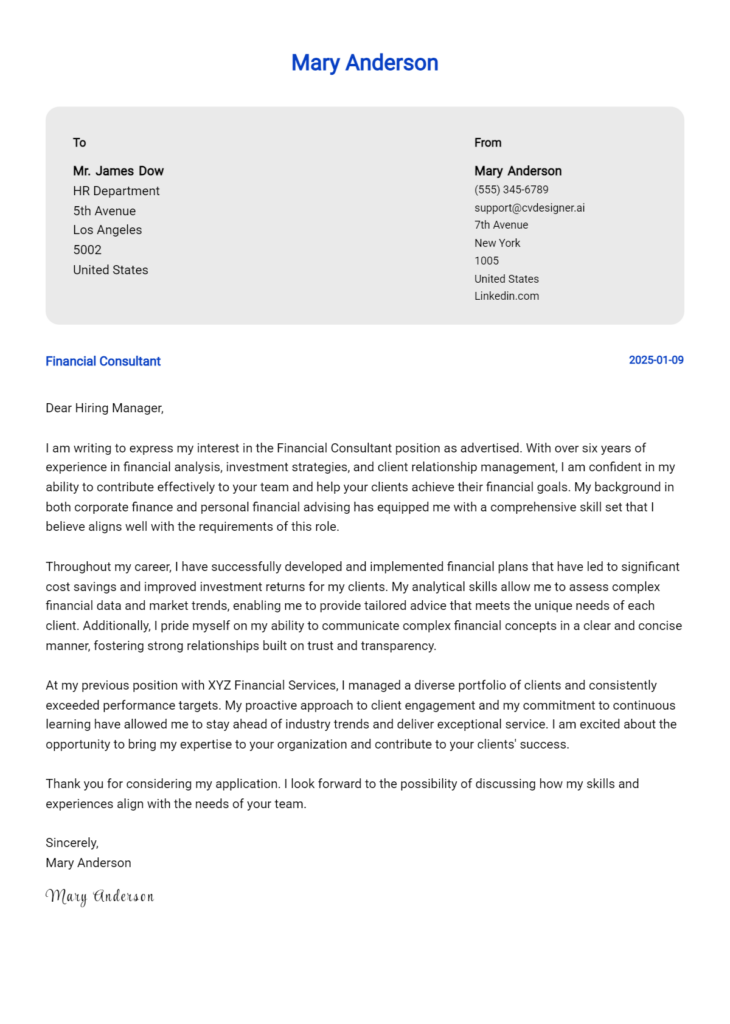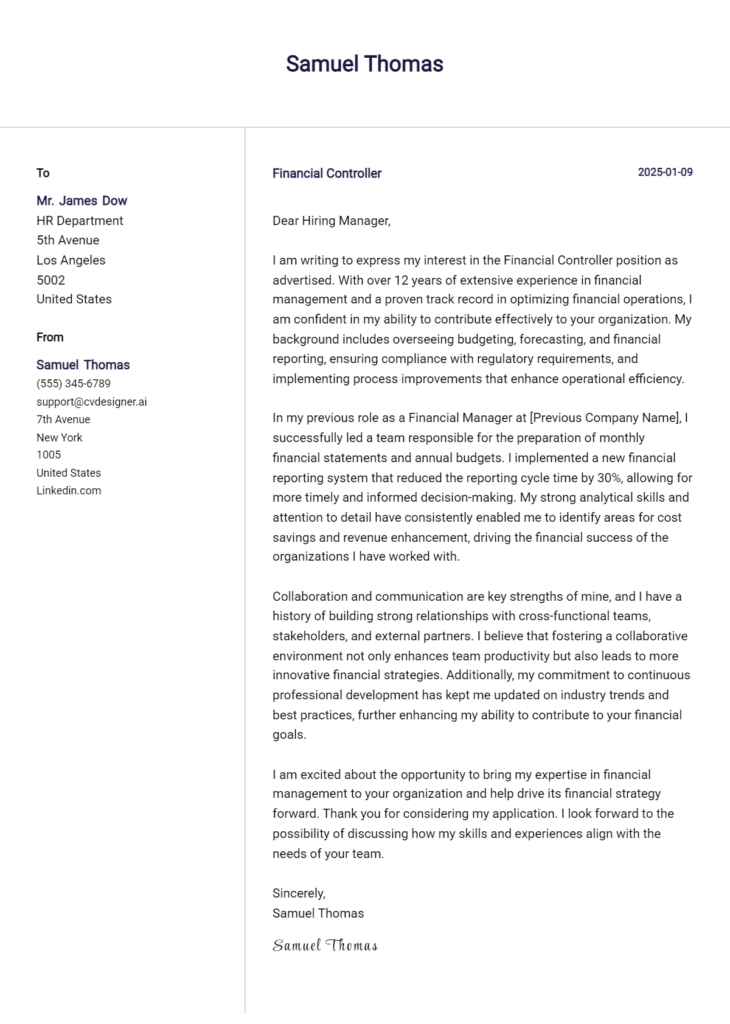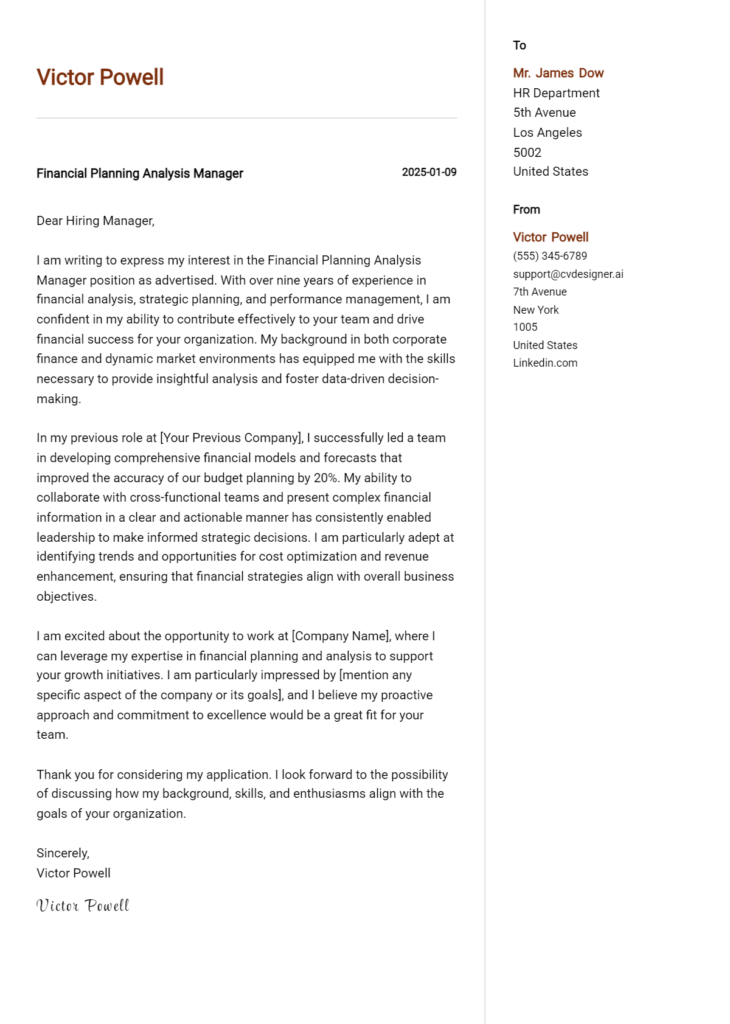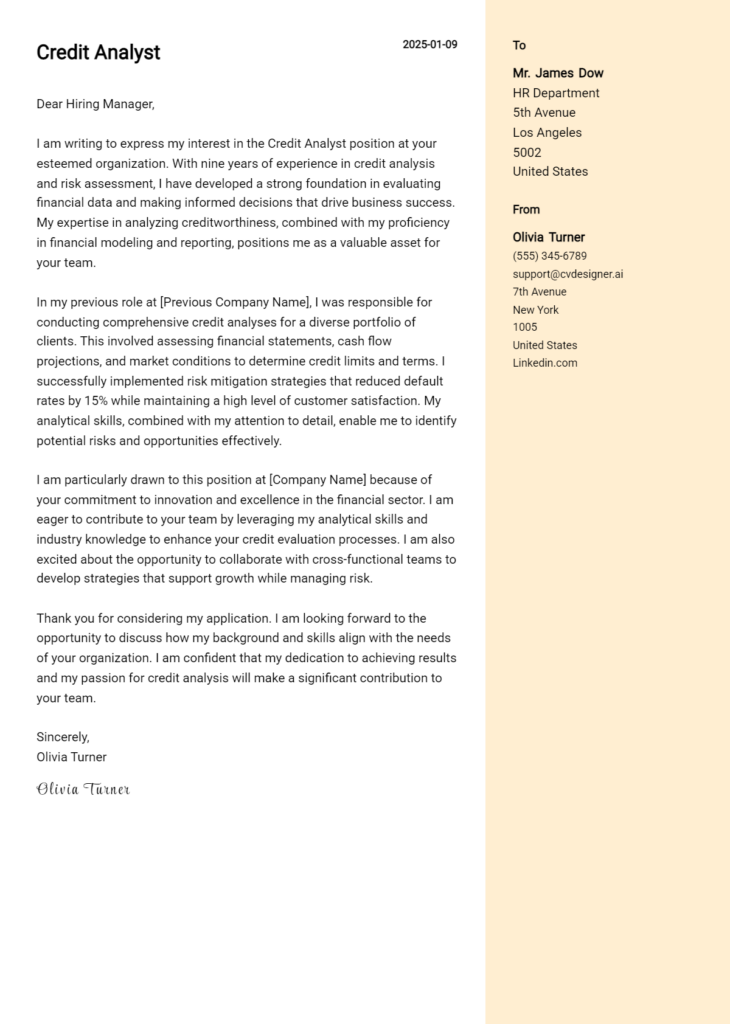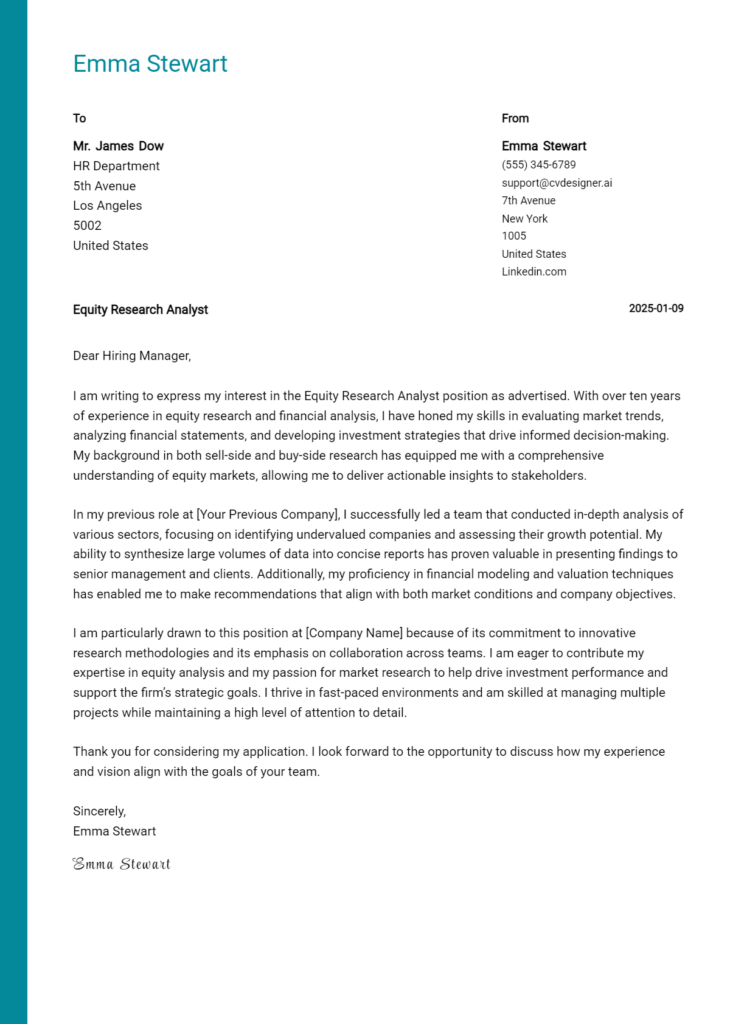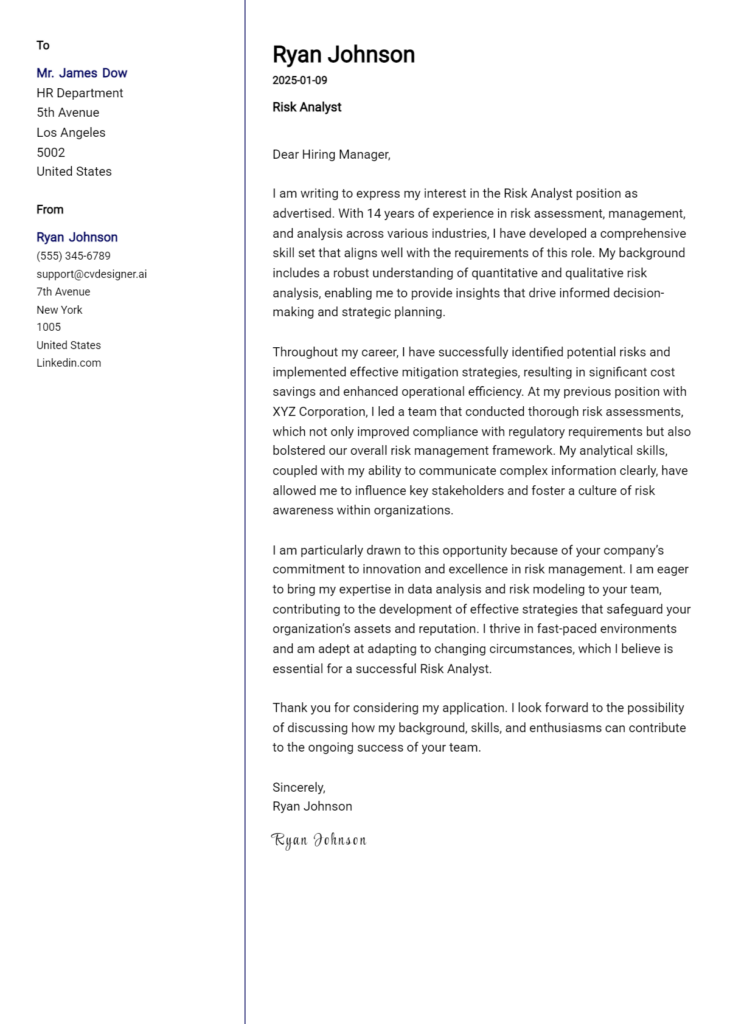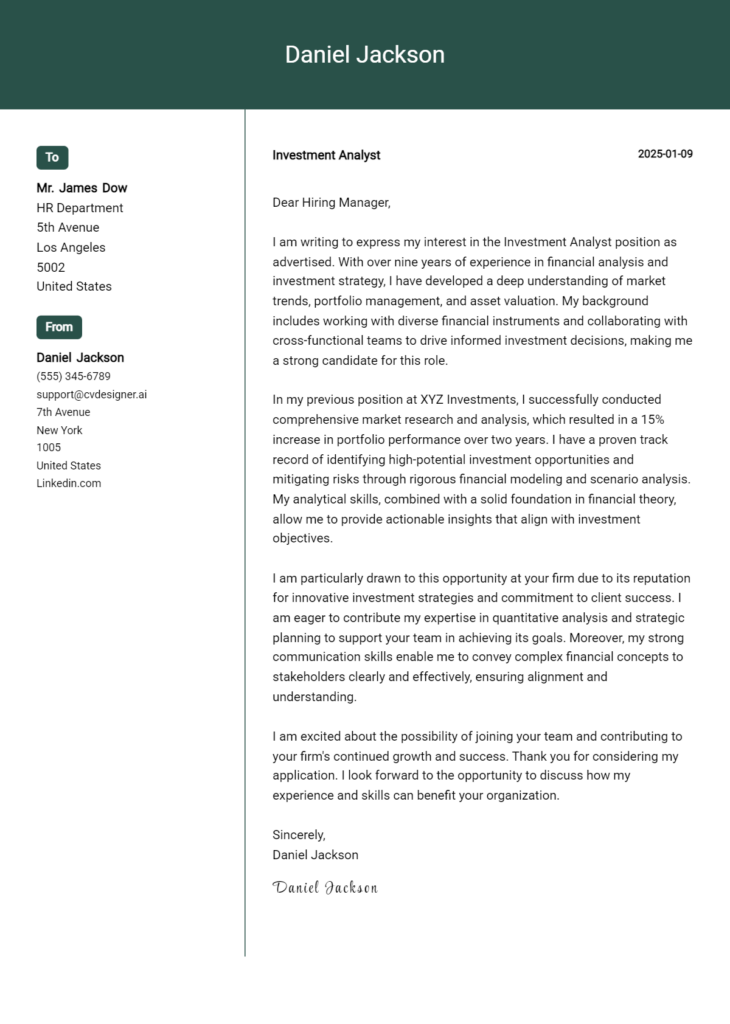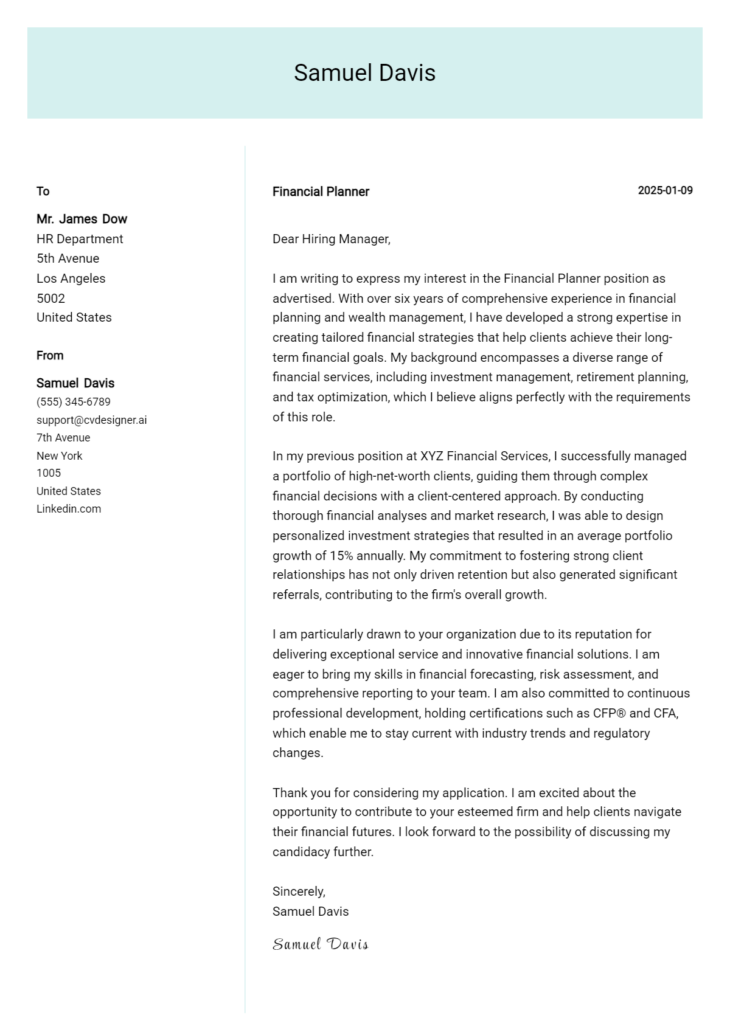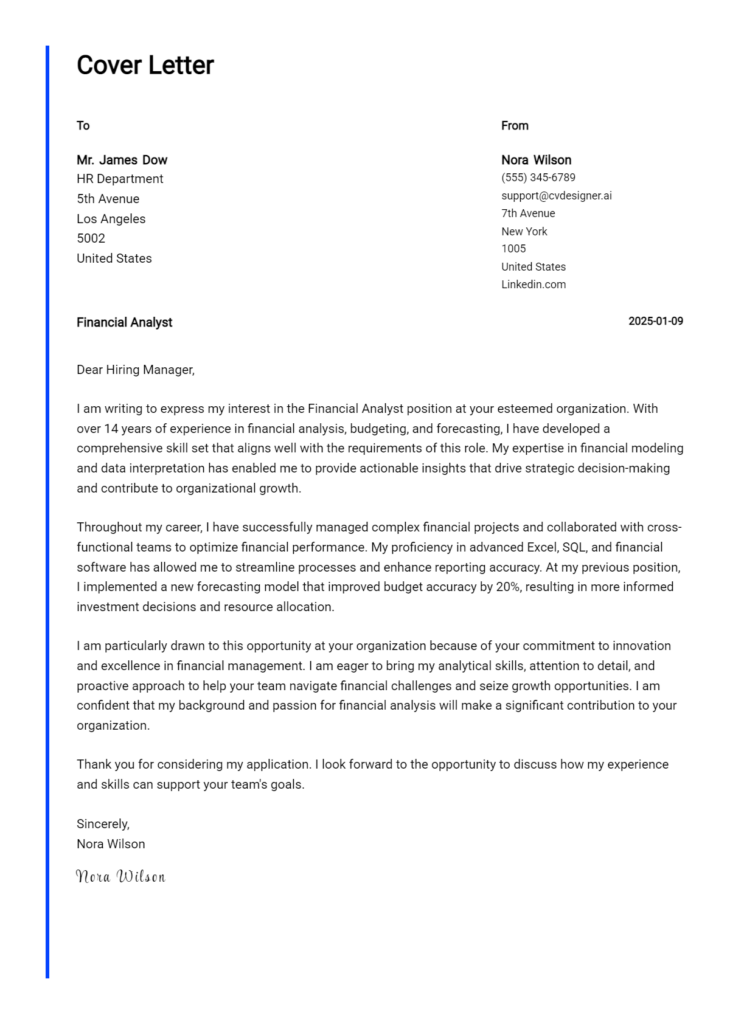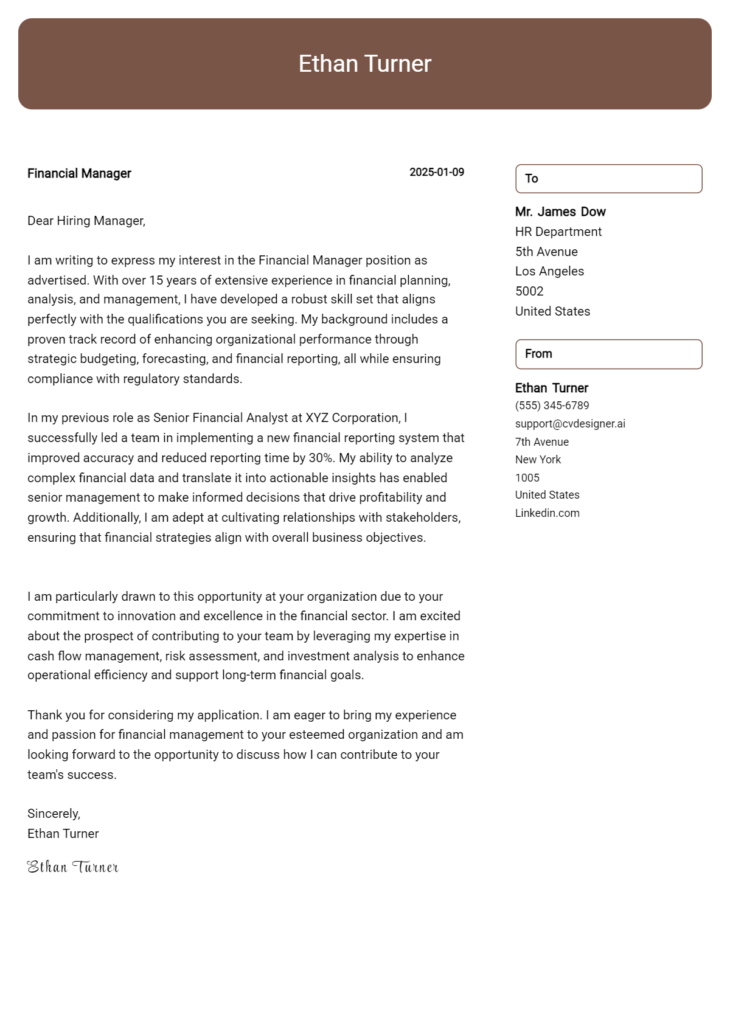Portfolio Manager Cover Letter Examples
Explore additional Portfolio Manager cover letter samples and guides and see what works for your level of experience or role.
How to Format a Portfolio Manager Cover Letter?
Crafting an effective cover letter for a Portfolio Manager position is essential, as it not only showcases your experience but also reflects your strategic thinking and ability to manage complex financial portfolios. The way you format your cover letter can significantly influence a hiring manager's perception of your professionalism and attention to detail—qualities that are paramount in the finance industry.
In this guide, we will explore the key elements of structuring your cover letter, providing insights and finance-specific examples to help you create a persuasive document.
We’ll focus on the critical components of a professional cover letter, including:
- Cover Letter Header
- Cover Letter Greeting
- Cover Letter Introduction
- Cover Letter Body
- Cover Letter Closing
Each section is crucial for emphasizing your qualifications and demonstrating your expertise in managing investment portfolios. Let’s delve into each part and learn how to make your Portfolio Manager cover letter truly stand out.
Importance of the Cover Letter Header for a Portfolio Manager
The cover letter header is a crucial component of any professional correspondence, especially for a Portfolio Manager, where clarity and professionalism can set the tone for the entire application. A well-structured header not only provides essential contact information but also establishes your credibility and attention to detail. It should include your name, address, phone number, email, the date, and the recipient's name and address. Ensuring that this information is presented clearly and concisely reflects your organizational skills, which are vital for a successful Portfolio Manager.
Strong Example
John Doe 123 Financial St. Invest City, XY 12345 (123) 456-7890 johndoe@email.com March 15, 2023 Jane Smith Head of Recruitment Wealth Management Corp 456 Capital Ave. Finance Town, XY 54321
Weak Example
johndoe@email.com 123 Financial St., Invest City March 15, 2023 Jane Smith Wealth Management Corp
The Importance of the Cover Letter Greeting for a Portfolio Manager
A well-crafted cover letter greeting is crucial as it sets the tone for the entire letter, establishing a sense of professionalism and respect for the recipient. Addressing the hiring manager directly not only personalizes your application but also demonstrates your attention to detail and genuine interest in the position. A generic greeting can make your cover letter appear impersonal and may suggest a lack of effort. To create a strong opening, take the time to research the recipient's name, which can be found on the company's website or LinkedIn. This simple step can significantly impact the impression you make.
Strong Greeting Example
Dear Ms. Johnson,
Weak Greeting Example
To Whom It May Concern,
Importance of a Well-Crafted Cover Letter Introduction for a Portfolio Manager
A well-crafted cover letter introduction is crucial for a Portfolio Manager as it sets the tone for the entire application. This opening paragraph should not only capture the hiring manager's attention but also express the candidate's enthusiasm for the role. It's an opportunity to briefly showcase key skills or achievements that align with the job description, making a compelling case for why the candidate is the right fit. A strong introduction can differentiate a candidate in a competitive field, while a weak one can cause even the most qualified applicant to be overlooked.
Strong Example
Dear [Hiring Manager's Name], As a seasoned Portfolio Manager with over seven years of experience in driving investment strategies that consistently outperform market benchmarks, I was thrilled to discover the opening at [Company Name]. My proven track record in managing diversified portfolios and my commitment to data-driven decision-making align perfectly with your team's goals. I am eager to bring my expertise in risk assessment and client relationship management to contribute to [Company Name]'s continued success.
Weak Example
Hello, I am writing to apply for the Portfolio Manager position. I have worked in finance for a while and have some experience. I think I would be a good fit for your team. Thank you for considering my application.
Purpose of the Cover Letter Body for a Portfolio Manager
The cover letter body for a Portfolio Manager serves as a critical component in demonstrating the candidate's expertise, relevant experience, and the unique value they bring to the organization. This section allows the applicant to elaborate on their skills in managing investment portfolios, analyzing market trends, and implementing strategic asset allocation. By highlighting specific projects or accomplishments—such as successfully managing a high-profile fund that outperformed market benchmarks or developing innovative investment strategies—the candidate can effectively convey their capability to contribute positively to the company's goals and objectives.
Strong Example
In my previous role at ABC Capital, I successfully managed a $150 million equity portfolio, achieving an annual return of 12% over three years, which exceeded our benchmark by 3%. One of my key projects involved the development of a data-driven model that identified undervalued stocks in emerging markets, resulting in a 25% increase in portfolio performance. Additionally, I led a cross-functional team to implement risk management strategies that minimized losses during market downturns, demonstrating my ability to adapt to changing market conditions and protect client investments.
Weak Example
I have worked in finance for several years and have some experience with managing portfolios. I think I would be a good fit for your company because I am interested in investments. I have helped some of my friends with their investment decisions, and I believe I can do the same for your clients. I am confident that I can learn quickly and contribute to your team.
Importance of the Cover Letter Closing for a Portfolio Manager
The closing paragraph of a cover letter is crucial for a Portfolio Manager, as it serves to summarize qualifications, reiterate enthusiasm for the role, and encourage the hiring manager to take the next steps, such as reviewing the resume or scheduling an interview. A strong closing can leave a lasting impression, reinforcing the candidate's fit for the position and their eagerness to contribute to the organization. Conversely, a weak closing may fail to convey confidence or a clear call to action, diminishing the overall impact of the application.
Strong Example
Thank you for considering my application for the Portfolio Manager position at [Company Name]. With over seven years of experience in investment strategy and risk management, I am excited about the opportunity to leverage my skills in driving portfolio performance and achieving client objectives. I am eager to discuss how my background aligns with your team’s goals. I look forward to the possibility of interviewing and exploring how I can contribute to [Company Name]’s continued success. Please feel free to contact me at your earliest convenience.
Weak Example
I hope you look at my resume. I think I have some relevant experience. If you want to talk, let me know. Thanks for your time.
These tips will assist candidates in crafting an effective cover letter for a Portfolio Manager position, a role that requires a unique blend of technical expertise and interpersonal skills. It’s crucial to showcase not only your technical skills but also your problem-solving abilities, understanding of the Software Development Life Cycle (SDLC), teamwork experiences, and a commitment to continuous learning. A well-structured cover letter can demonstrate your qualifications and enthusiasm for the role, making a strong impression on potential employers.
Tips for Writing a Cover Letter for a Portfolio Manager Position
Highlight Technical Skills: Clearly outline your technical proficiencies relevant to portfolio management. Include specific tools, technologies, and methodologies you are familiar with, such as Agile, Scrum, or specific project management software. Providing concrete examples of how you have applied these skills in previous roles will strengthen your case.
Emphasize Problem-Solving Abilities: Share instances where you successfully identified and resolved complex issues in past projects. Discuss your analytical approach and how you utilized data to inform decisions. This will illustrate your critical thinking capabilities and your ability to navigate challenges effectively.
Demonstrate SDLC Knowledge: Showcase your understanding of the Software Development Life Cycle by detailing your experience with different phases, from planning and design to testing and deployment. Mention specific projects where you played a significant role in managing these phases and how your contributions drove project success.
Showcase Teamwork and Collaboration: Portfolio Managers often work with cross-functional teams, so it’s important to highlight your collaborative experiences. Provide examples of how you worked with developers, stakeholders, and other team members to achieve project goals. Emphasize your ability to communicate effectively and to foster a positive team environment.
Express a Passion for Continuous Learning: The tech landscape is ever-evolving, and a successful Portfolio Manager must stay current with industry trends and new technologies. Mention any relevant certifications, courses, or personal projects that demonstrate your commitment to professional development. This will convey your proactive mindset and willingness to adapt to new challenges.
Common Mistakes to Avoid in a Portfolio Manager Cover Letter
Crafting an effective cover letter is essential for standing out in the competitive field of portfolio management. Avoiding common mistakes can significantly enhance your chances of making a positive impression. Here are some pitfalls to steer clear of:
Generic Greetings: Using "To Whom It May Concern" can make your application seem impersonal. Instead, research the hiring manager's name and use it to personalize your greeting.
Lack of Specificity: Failing to mention relevant skills or experiences specific to the job can weaken your application. Tailor your cover letter to highlight key achievements that align with the role.
Overly Lengthy Content: A cover letter that is too long can lose the reader's interest. Aim for a concise and focused letter that captures your qualifications in a few paragraphs.
Neglecting to Showcase Results: Merely listing responsibilities without demonstrating outcomes can diminish your impact. Use metrics and specific examples to showcase how you've successfully managed portfolios in the past.
Ignoring Company Culture: Not addressing how your values align with the company's culture can be a missed opportunity. Research the firm's mission and incorporate relevant aspects into your letter.
Poor Formatting: A cluttered or unprofessional format can detract from your message. Use a clean layout with clear headings and bullet points to improve readability.
Spelling and Grammar Errors: Typos can undermine your professionalism. Always proofread your letter, or seek a second opinion to catch any mistakes before submission.
By avoiding these common mistakes, you can create a compelling cover letter that effectively showcases your qualifications as a portfolio manager.
Cover Letter FAQs for Portfolio Manager
What key skills should I highlight in my cover letter for a Portfolio Manager position?
When applying for a Portfolio Manager position, it’s crucial to highlight skills such as financial analysis, risk management, and investment strategy development. Emphasize your ability to assess and allocate assets effectively while demonstrating a strong understanding of market trends. Additionally, showcase your proficiency with financial modeling and analytics tools, as well as your experience in managing client relationships and expectations. Soft skills like communication, leadership, and strategic thinking are equally important; they reflect your capability to guide clients through complex financial landscapes and make informed decisions. Tailor your examples to demonstrate how these skills have led to successful outcomes in your previous roles.
How should I structure my cover letter for a Portfolio Manager role?
A well-structured cover letter typically includes an introduction, body, and conclusion. Start with a strong opening that captures the hiring manager’s attention; mention the position you’re applying for and express your enthusiasm for the company. In the body, clearly outline your relevant experience, focusing on specific achievements and skills that align with the job description. Use bullet points to highlight key accomplishments for clarity and impact. In your conclusion, reiterate your interest in the position and how your expertise aligns with the company’s goals. Finish with a professional closing and express your eagerness for an interview to discuss your qualifications further.
How can I demonstrate my understanding of the financial market in my cover letter?
To showcase your understanding of the financial market, incorporate recent trends, challenges, and opportunities that are relevant to the role. Mention specific events or changes in the market and how they impact investment strategies. For example, you might reference fluctuations in interest rates or the impact of regulatory changes on portfolio management. Additionally, you can discuss how you’ve navigated similar market conditions in past roles by implementing proactive strategies or adjusting investment allocations. Highlighting your knowledge of various asset classes, market indicators, and economic factors shows that you are not only qualified but also engaged and proactive in your field.
Should I customize my cover letter for each Portfolio Manager application?
Absolutely! Customizing your cover letter for each application is essential. This approach demonstrates your genuine interest in the specific position and company, setting you apart from generic applications. Research the company’s investment philosophy, recent performance, and key challenges they face in the market. Use this information to tailor your cover letter, aligning your skills and experiences with their needs. For instance, if the company focuses on sustainable investments, highlight your experience in ESG (Environmental, Social, and Governance) portfolio management. Customization shows that you’ve done your homework and are committed to contributing to their goals, increasing your chances of making a positive impression.
Build your Cover Letter in minutes
Use an AI-powered cover letter builder and have your letter done in 5 minutes. Just select your template and our software will guide you through the process.

